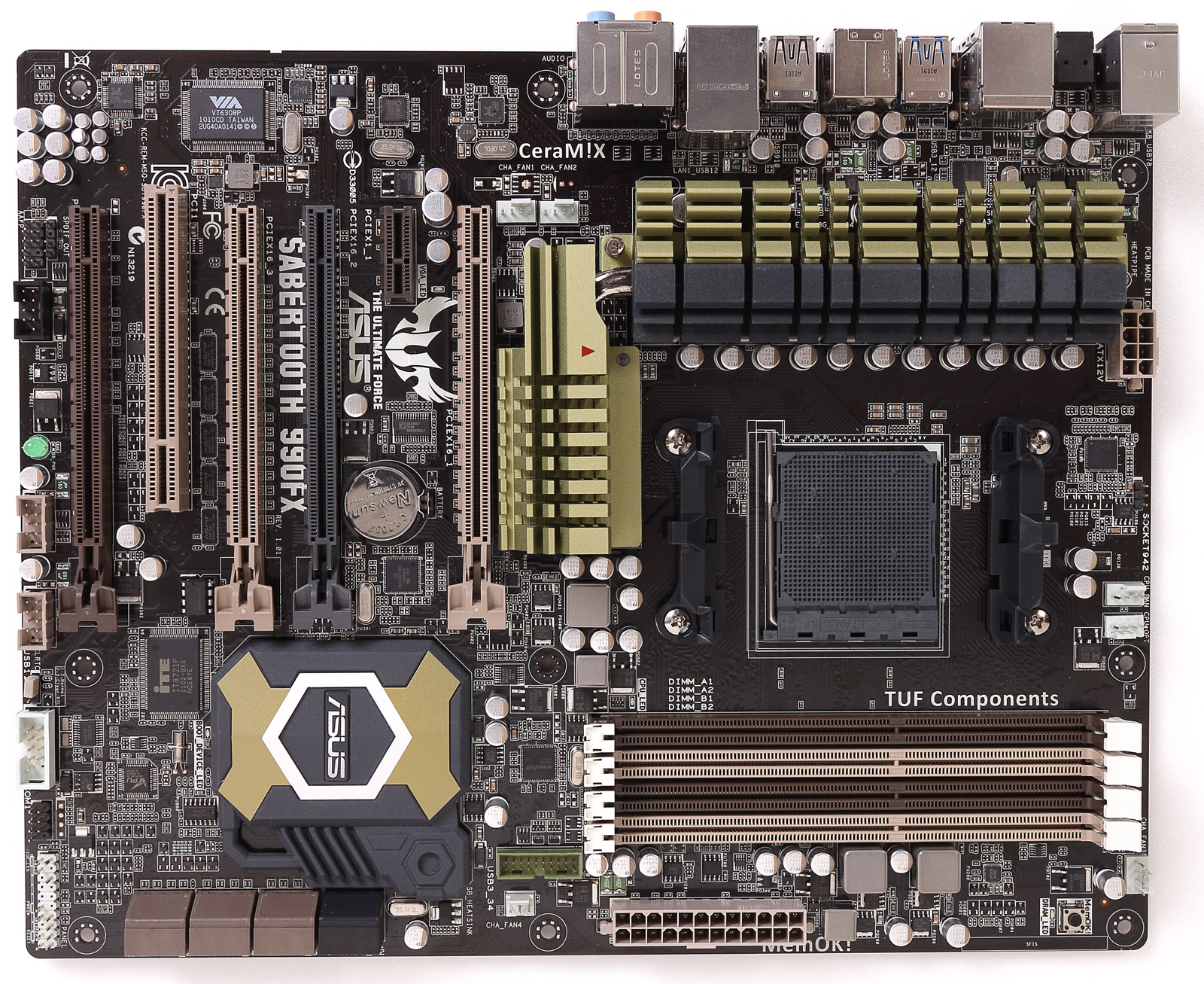The 990FX Chipset Arrives: AMD And SLI Rise Again
AMD is laying the foundation for its Socket AM3+, Bulldozer-based Zambezi processors with the 990FX chipset, functionally identical to 890FX. The big news is that motherboard vendors are licensing SLI again, and we want to compare performance to Intel.
990FX Boards From Asus And MSI
We received two platforms ahead of today’s roundup. One arrived early from Asus, and the other showed up a little later from MSI. Because we had the Asus board set up and running tests already, that’s the one we used for benchmarking.
Asus Sabertooth 990FX
Asus is estimating that its Sabertooth 990FX will cost $209—the same price, incidentally, as the P8Z68-V Pro motherboard we’re using for comparison.
The board supports up to four GPUs using two cards, or up to three-way CrossFire or three-way SLI. As with the 890FX before it, 990FX feature 42 lanes of second-gen PCI Express, 32 of which can be used on a pair of graphics cards. Technically, the chipset also supports four cards with eight lanes apiece, but Asus doesn’t support that configuration, instead running up to three discrete cards at x16/x8/x8.
Complementing 990FX is AMD’s SB950 southbridge. Contrary to early rumors, this part doesn’t support USB 3.0 (that’ll have to wait until AMD’s first Fusion Controller Hubs debut next month). No, SB950 is, again, identical to its predecessor, which means Asus has to add USB 3.0 through a pair of ASMedia controllers. Fortunately, the AMD southbridge carries over SB850’s six SATA 6Gb/s ports, and all of those are exposed along the board’s bottom-right edge, along with two 3 Gb/s connectors enabled by a JMicron JMB362. A second JMicron controller facilitates two eSATA ports.
Of course, Asus adds its own unique mix of features to the board as well. This platform is shuffled into the TUF series, which emphasizes stability and durability. We’re happy to report that the Sabertooth 990FX did, in fact, operate flawlessly through testing. Should it become part of your next build (rather than a subject on our open-air bench), you’ll be happy to know it features a total of six fan headers, 10 thermal sensors, and a feature Asus calls TUF Thermal Radar, used to identify hot spots and adjust fan performance in response.
MSI 990FXA-GD80
Get Tom's Hardware's best news and in-depth reviews, straight to your inbox.
We didn’t have time to run MSI’s 990FXA-GD80 through the same gauntlet as the Asus board, but we still wanted to show off the difference between both platforms. Whereas the Sabertooth’s focus is clearly on reliability and subdued, earthy colors, MSI spices things up with its dark blue/grey/black motif.
From a functionality standpoint, MSI includes most of the same capabilities as Asus—notably three-way SLI and CrossFire support, that black AM3b socket interface, plenty of USB 3.0 connectivity, and six 6 Gb/s SATA ports emanating from the SB950 southbridge.
MSI is short one internal SATA 3Gb/s controller versus Asus’ implementation. However, the 990FXA-GD80 does include onboard power/reset buttons—a feature awkwardly missing from the Sabertooth.
Current page: 990FX Boards From Asus And MSI
Prev Page 990FX: Socket AM3+ Meets SLI Next Page Hardware And Benchmark Setup-
nice to see support for both videocard producers. especialy for nvidia. now you can do amd+nvidia not only amd+ati(amd)Reply
-
stingstang Tom's, what the hell is this? "At the end of the day, it's the graphics cards which are the bottleneck."Reply
Did you go about benchmarking graphics cards, or was this a motherboard/cpu comparison? I'm tired of hearing this excuse all the time. We know you have a pair of 6990s and 590s in your shop. Get rid of that stupid bottleneck and DO IT RIGHT! -
saint19 I'd keep in mind that this performance review was made it with an AM3 CPU and not with the new generation.Reply -
-Fran- Thanks for the review, but at lower resolutions we all know that the CPU differences will become clear. So you just proved that if a game is taxing on the GPUs, both solutions are equal and when the graphics card ain't being taxed, CPU differences become apparent... Ok, thanks for proving what we already know once more (not being sarcastic here >_Reply -
-Fran- Uhm... that last comment of mine was cut in half with the missing char of that face... I guess that's an escape char; oh well.Reply
What is missing said something like:
...here "face"), but you said you wanted to test AMD's SLI on their 990FX vs Intel's SLI. So, IMO, you need less graphics horse power: like 2 GTS250's or 2 GTX460's or 2 GTX560's (not ti's) to tax the graphics subsystem and really show the differences. Maybe up the resolution also to really show if there is a difference between AMD's or Intel's SLI.
Thanks again for the Article, Mr Chris.
Cheers!






